Detection and identification of potential biomarkers of breast cancer
- PMID: 20237941
- PMCID: PMC11827925
- DOI: 10.1007/s00432-010-0775-1
Detection and identification of potential biomarkers of breast cancer
Abstract
Purpose: Noninvasive and convenient biomarkers for early diagnosis of breast cancer remain an urgent need. The aim of this study was to discover and identify potential protein biomarkers specific for breast cancer.
Methods: Two hundred and eighty-two (282) serum samples with 124 breast cancer and 158 controls were randomly divided into a training set and a blind-testing set. Serum proteomic profiles were analyzed using SELDI-TOF-MS. Candidate biomarkers were purified by HPLC, identified by LC-MS/MS and validated using ProteinChip immunoassays and western blot technique.
Results: A total of 3 peaks (m/z with 6,630, 8,139 and 8,942 Da) were screened out by support vector machine to construct the classification model with high discriminatory power in the training set. The sensitivity and specificity of the model were 96.45 and 94.87%, respectively, in the blind-testing set. The candidate biomarker with m/z of 6,630 Da was found to be down-regulated in breast cancer patients, and was identified as apolipoprotein C-I. Another two candidate biomarkers (8,139, 8,942 Da) were found up-regulated in breast cancer and identified as C-terminal-truncated form of C3a and complement component C3a, respectively. In addition, the level of apolipoprotein C-I progressively decreased with the clinical stages I, II, III and IV, and the expression of C-terminal-truncated form of C3a and complement component C3a gradually increased in higher stages.
Conclusions: We have identified a set of biomarkers that could discriminate breast cancer from non-cancer controls. An efficient strategy, including SELDI-TOF-MS analysis, HPLC purification, MALDI-TOF-MS trace and LC-MS/MS identification, has been proved very successful.
Figures
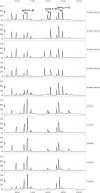
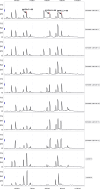
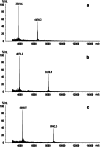
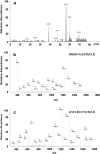
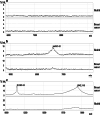
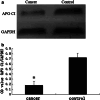
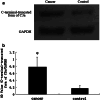
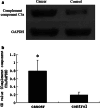
Similar articles
-
SELDI-TOF MS profiling of serum for detection of laryngeal squamous cell carcinoma and the progression to lymph node metastasis.J Cancer Res Clin Oncol. 2008 Jul;134(7):769-76. doi: 10.1007/s00432-007-0344-4. Epub 2008 Jan 17. J Cancer Res Clin Oncol. 2008. PMID: 18202856 Free PMC article.
-
Discovery and identification of potential biomarkers of papillary thyroid carcinoma.Mol Cancer. 2009 Sep 28;8:79. doi: 10.1186/1476-4598-8-79. Mol Cancer. 2009. PMID: 19785722 Free PMC article.
-
Cost-effectiveness of using prognostic information to select women with breast cancer for adjuvant systemic therapy.Health Technol Assess. 2006 Sep;10(34):iii-iv, ix-xi, 1-204. doi: 10.3310/hta10340. Health Technol Assess. 2006. PMID: 16959170
-
Highly accurate detection of ovarian cancer using CA125 but limited improvement with serum matrix-assisted laser desorption/ionization time-of-flight mass spectrometry profiling.Int J Gynecol Cancer. 2010 Dec;20(9):1518-24. doi: 10.1111/IGC.0b013e3181fc1990. Int J Gynecol Cancer. 2010. PMID: 21370595
-
[Volume and health outcomes: evidence from systematic reviews and from evaluation of Italian hospital data].Epidemiol Prev. 2013 Mar-Jun;37(2-3 Suppl 2):1-100. Epidemiol Prev. 2013. PMID: 23851286 Italian.
Cited by
-
Identification of Apolipoprotein C-I Peptides as a Potential Biomarker and its Biological Roles in Breast Cancer.Med Sci Monit. 2016 Apr 7;22:1152-60. doi: 10.12659/msm.896531. Med Sci Monit. 2016. PMID: 27052600 Free PMC article.
-
Identification of apolipoprotein C-I as a potential Wilms' tumor marker after excluding inflammatory factors.Int J Mol Sci. 2014 Sep 12;15(9):16186-95. doi: 10.3390/ijms150916186. Int J Mol Sci. 2014. PMID: 25222555 Free PMC article.
-
Diagnostic and prognostic role of serum protein peak at 6449 m/z in gastric adenocarcinoma based on mass spectrometry.Br J Cancer. 2016 Apr 12;114(8):929-38. doi: 10.1038/bjc.2016.52. Epub 2016 Mar 22. Br J Cancer. 2016. PMID: 27002935 Free PMC article.
-
Long intergenic non-coding RNA APOC1P1-3 inhibits apoptosis by decreasing α-tubulin acetylation in breast cancer.Cell Death Dis. 2016 May 26;7(5):e2236. doi: 10.1038/cddis.2016.142. Cell Death Dis. 2016. PMID: 27228351 Free PMC article.
-
Proteomic serum biomarkers and their potential application in cancer screening programs.Int J Mol Sci. 2010 Oct 26;11(11):4175-93. doi: 10.3390/ijms11114175. Int J Mol Sci. 2010. PMID: 21151433 Free PMC article. Review.
References
-
- Agyei Frempong MT, Darko E, Addai BW (2008) The use of carbohydrate antigen (CA) 15-3 as a tumor marker in detecting breast cancer. Pak J Biol Sci 11:1945–1948 - PubMed
-
- Belluco C, Petricoin EF, Mammano E, Facchiano F, Ross-Rucker S, Nitti D, Di Maggio C, Liu C, Lise M, Liotta LA, Whiteley G (2007) Serum proteomic analysis identifies a highly sensitive and specific discriminatory pattern in stage 1 breast cancer. Ann Surg Oncol 14:2470–2476 - PubMed
-
- Cherel P, Hagay C, Benaim B, De Maulmont C, Engerand S, Langer A, Talma V (2008) Mammographic evaluation of dense breasts: techniques and limits. J Radiol 89:1156–1168 - PubMed
-
- De Gelder R, van As E, Tilanus-Linthorst MM, Bartels CC, Boer R, Draisma G, de Koning HJ (2008) Breast cancer screening: evidence for false reassurance? Int J Cancer 123:680–686 - PubMed
Publication types
MeSH terms
Substances
LinkOut - more resources
Full Text Sources
Other Literature Sources
Medical

